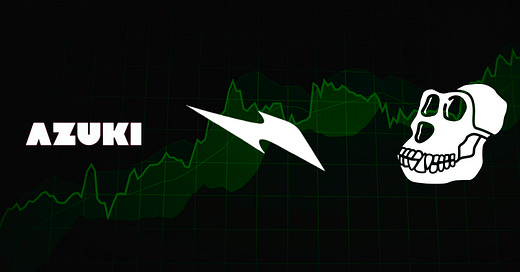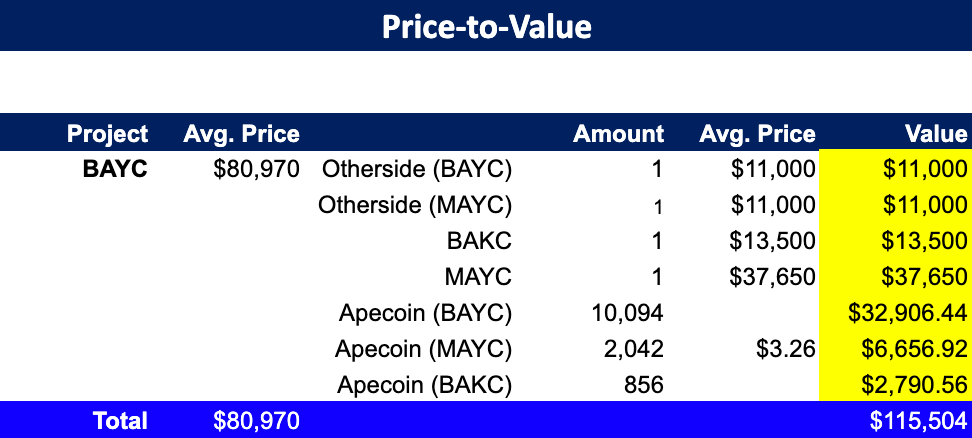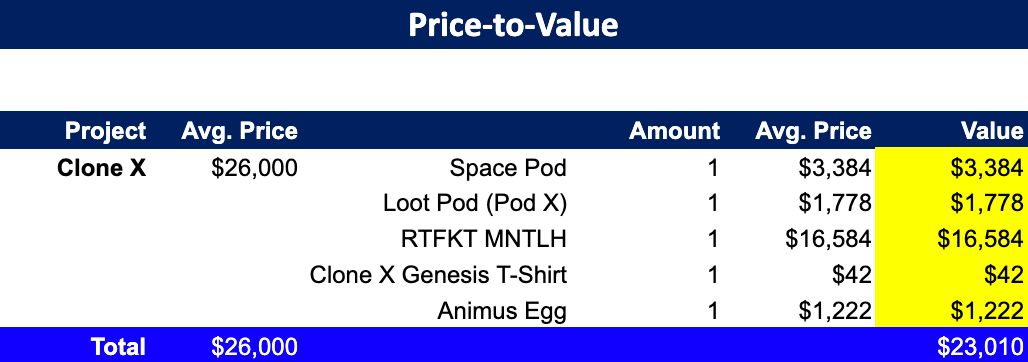A New Way to Value NFTs – Comparing BAYC, Clone X and Azuki
Find out whether Bored Ape Yacht Club, Clone X or Azuki perform the best using the price-to-value ratio.
The Naked Collector is the home of the latest news and deepest analyses of Web3 Fashion and Culture. Subscribe now and receive a free report.
Hope most of you read the last issue i.e. The State of Fashion NFTs 2022. It should’ve given you a better understanding of Fashion and NFTs beyond just the headlines you see on LinkedIn and Twitter.
In this newsletter, you’ll :
Find out a new method to value NFT projects
See how Bored Ape Yacht Club, Clone X and Azuki stack up against each other using the metric
Price-to-Value (P/V) Ratio
The P/V metric indicates how much value holders have received from airdrops (or free claims) relative to the price they’ve paid for the cornerstone (or parent) NFT. If the figure is more than 1, holders have generally on average paid more for the cornerstone NFTs than what they’ve received in return. If it’s less than 1, holders have received more value than what they’ve paid. The assumption is that the holder holds onto all of the airdropped collections e.g. BAYC → BAYC + BAKC + MAYC.
For the finance-minded, the P/V metric is somewhere between a PE ratio, return on investment (ROI) and a dividend yield (if P/V is inverted), in traditional finance. In some ways, airdrops are akin to earnings (i.e. P/V is similar to the PE ratio) as the new collections are often new profit-generating product lines. Airdrops may also have voting rights similar to common stock (e.g. Apecoin). On the other hand, holders of NFT projects “earn” from airdrops, not project royalties. In other ways, P/V is similar to ROI as it is viewed from the point of view of the holder or investor. Then again, airdrops are distributed to holders at the discretion of the NFT project teams in part to incentivize holders to retain ownership of their NFTs, similar to dividends.
While I’m probably not the first to come up with the P/V ratio, so far, I haven’t seen it utilized anywhere. In this sense, you may be among the first ones to discover it.
Let’s get into the P/V ratios for Bored Ape Yacht Club, RTFKT and Azuki. Remember the lower the P/V ratio the better. So which collections have offered the best bang for one’s buck?
Bored Ape Yacht Club = 0.70
Airdrops:
Bored Ape Yacht Club (BAYC) has relied quite heavily on the airdrop strategy, which explains its low P/V value. In June 2021, each BAYC NFT was airdropped a Bored Ape Kennel Club (BAKC). Later in August 2021, each BAYC was airdropped a Mutant serum that holders could use to create a Mutant Ape Yacht Club (MAYC) NFT. 10,000 MAYCs were also sold to the public at 3ETH mint price (not included in the calculations). In March 2022, free Apecoin could be claimed (see amounts below) and in April 2022 BAYC and MAYC holders were airdropped one Otherdeed for Otherside land per each BAYC or MAYC held.
Calculations:
BAYC has a P/V ratio of 0.70. Looking at the graph below, we can see BAYC has had an averate lifetime price of $81,000. The value of airdrops to BAYC holders using average prices is $115,500. $81,000/$115,500 = 0.70.
The highest returns came from MAYC and Apecoin (BAYC), while the lowest return came from Apecoin (BAKC) i.e. the extra Apecoin you received if you held MAYC + BAKC.
The specific calculations are shown in the table below:
RTFKT Clone X = 1.13
Airdrops:
RTFKT’s Clone X price-to-value is slightly higher than BAYC’s, which means their return from airdrops has been worse than BAYC’s. RTFKT airdropped Space Pods to Clone X holders as a Christmas present on the 25th of December 2021. Later in February 2022, each Space Pod holder was airdropped a Loot Pod (Pod X), while each Clone X holder was airdropped a MNLTH 1.
In April 2022, MNTLH 1 holders were able to burn their NFTs to receive a MNTLH 2, a Cryptokick and a Skin Vial.
In December 2022, the MNLTH 2 was automatically transformed into the Trillium Lace Engine, and holders were airdropped MNLTH X. Read more about the process here.
Prior to the MNLTH X airdrop, in September 2022 Clone X Genesis T-Shirts and in December 2022 RTFKT Animus Eggs could be claimed for free by Clone X holders.
Calculations:
RTFKT Clone X has a P/V ratio of 1.13. Looking at the graph below we can see Clone X has had a lifetime average price of f$26,000. The value of airdrops to Clone X holders using average prices is $23,010. $26,000/$23,010 = 1.13.
The highest return came by far from RTFKT MNLTH 1, the lowest from the phygital Clone X Genesis T-Shirt.
The specific calculations are shown in the table below:
I excluded MNLTH X, Nike Cryptokicks and Mint Vials since holders had to burn the MNLTH 1 to receive them. Hence, MNLTH 1 also acts as a value proxy for the three collections. Space Pod and Loot Pod are both included since holders didn’t have to burn the Space Pod to receive a Loot Pod.
Azuki = 1.91
Airdrops:
Azuki has had the least airdrops compared to the other two projects, which explains its higher (i.e. worse) P/V ratio. In March 2022 two Beanz NFTs were airdropped to each Azuki holder and in May 2022,each Azuki could mint a free phygital Twin Tigers Jacket.
Calculations:
Azuki has a P/V ratio of 1.91. Looking at the graph below Azuki has had an average lifetime price of $25,078. The value of airdrops to Azuki holders using average prices is $13,154. $25,078/$13,154 = 1.91.
The biggest return comes by far from Beanz. The Azuki Twin Tigers jacket was claimable for around three months, after which the token became essentially worthless, explaining the lower price. Also, based on my previous research phygital goods typically fetch lower prices than PFP or digital-only items.
The specific calculations are shown in the table below:
Takeaways
You can utilize the P/V metric to measure an NFT project’s:
Reliance on airdrops
A low P/V can indicate heavy use of airdrops
Ability to generate demand for secondary collections (i.e. airdrops)
A low P/V can indicate the collection airdrops are desirable and maintain their value
Underpricing
A low P/V can imply that the parent NFT collection is underpriced relative to its airdrop value (assuming there will be further airdrops)
A low P/V can also indicate that the secondary collections (airdrops) have maintained their value better than their parent collection
Having said this, the P/V metric isn’t perfect. For instance, the timing of the cornerstone NFT purchase has significant implications on how much of the subsequent airdrop value is received. If it’s acquired after the airdrop then you miss out on value. Also, keep in mind that this is not financial advice. A low P/V value doesn’t necessarily imply that the project is better as there are other ways to gain from NFTs than airdrops e.g. access and capital gains of the cornerstone collection. Instead, look at P/V as one of the tools you can use to assess a project’s reliance on airdrops, ability to generate demand for secondary collections and underpricing of the parent collection.
Links
Previous article on The State of Fashion NFTs 2022
If you are a Web2 company looking to get into Web3 or a Web3 project, I'd love to work with you! Just shoot me a DM.
Author Bio
I focus on the cross-section of NFTs, crypto and fashion:
Naked Collector has been the top Web3 Fashion research/data source since 2021
5+ years of experience in crypto markets
Part of 100+ NFT communities
Followed by the top Web2 fashion brands (e.g. Adidas, Prada, Ralph Lauren) and the most influential trendsetters in the Web3 Fashion/Digital Fashion space












